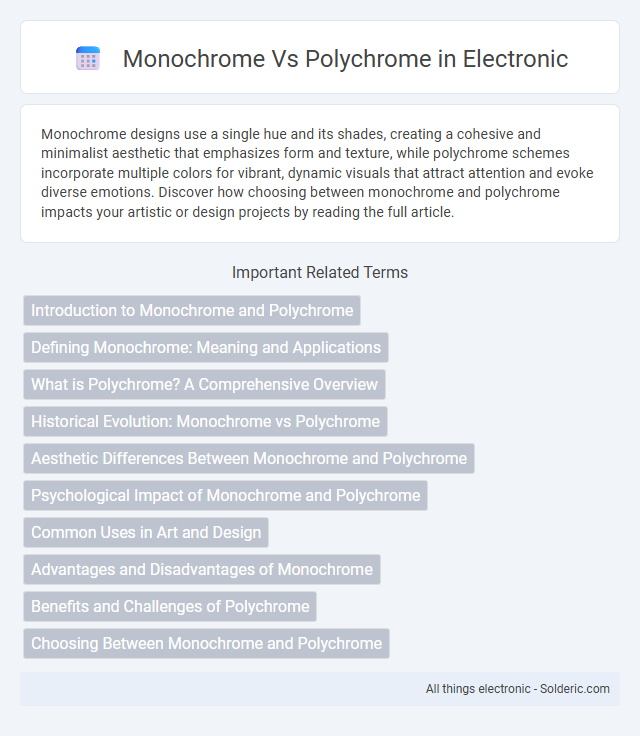Monochrome designs use a single hue and its shades, creating a cohesive and minimalist aesthetic that emphasizes form and texture, while polychrome schemes incorporate multiple colors for vibrant, dynamic visuals that attract attention and evoke diverse emotions. Discover how choosing between monochrome and polychrome impacts your artistic or design projects by reading the full article.
Comparison Table
| Aspect | Monochrome | Polychrome |
|---|---|---|
| Definition | Uses single color or shades of one color | Uses multiple colors |
| Visual Impact | Minimalistic, elegant | Vibrant, dynamic |
| Common Use | Photography, art, design for focus and mood | Painting, advertising, branding for richness and attention |
| Complexity | Simple and clean | Complex and detailed |
| Example Colors | Black, white, grayscale | Red, blue, green, yellow, multi-color palettes |
| Emotional Effect | Calm, serious, sophisticated | Energetic, cheerful, engaging |
| Technical Use | Reduced file size, easier printing | Accurate color representation, visual complexity |
Introduction to Monochrome and Polychrome
Monochrome refers to images or designs composed of varying shades of a single color, often emphasizing contrast and simplicity. Polychrome incorporates multiple colors to create vibrant, dynamic visuals that appeal to diverse aesthetic preferences. These two approaches highlight distinct artistic and design philosophies focused on color usage and emotional impact.
Defining Monochrome: Meaning and Applications
Monochrome refers to images or designs that utilize variations of a single color, often including different shades, tints, and tones to create depth and contrast. This approach is widely applied in art, photography, and design to emphasize texture, form, and composition without the distraction of multiple colors. Your projects can benefit from monochrome's simplicity, enhancing clarity and emotional impact through focused color schemes.
What is Polychrome? A Comprehensive Overview
Polychrome refers to the use of multiple colors in art, architecture, or design, contrasting with monochrome's single-color scheme. This technique enhances visual interest and depth by combining various hues, often applied in painting, sculpture, and decorative elements. Polychrome is essential in historical artworks, religious iconography, and cultural artifacts, showcasing intricate color compositions that convey meaning and emotion.
Historical Evolution: Monochrome vs Polychrome
Monochrome art, characterized by a single color or shades of one hue, traces back to prehistoric cave paintings where limited pigments were used. Polychrome art emerged prominently during the Renaissance, incorporating multiple colors to enhance realism and emotional expression in religious and secular works. Throughout history, cultural significance and technological advances in pigments influenced the dynamic interplay between monochrome and polychrome styles in various artistic movements.
Aesthetic Differences Between Monochrome and Polychrome
Monochrome designs emphasize simplicity by using varying shades of a single color, creating a harmonious and elegant aesthetic that often evokes calmness and sophistication. Polychrome compositions, on the other hand, utilize multiple colors to produce vibrant, dynamic visuals that capture attention and convey energy or complexity. Your choice between monochrome and polychrome affects the visual impact and mood, tailoring the overall aesthetic experience to specific design goals or emotional responses.
Psychological Impact of Monochrome and Polychrome
Monochrome color schemes evoke a sense of calmness, simplicity, and sophistication by using variations of a single hue, which can enhance focus and reduce visual clutter in your environment. Polychrome palettes, incorporating multiple colors, stimulate creativity, energy, and emotional engagement, making spaces feel vibrant and dynamic. Understanding the psychological impact of these color choices helps you create atmospheres tailored for relaxation or motivation based on your needs.
Common Uses in Art and Design
Monochrome artwork often emphasizes texture, form, and contrast by using variations of a single hue, making it popular in minimalist design, photography, and classical ink paintings. Polychrome art employs multiple colors to convey depth, emotion, and vibrancy, frequently seen in murals, digital illustrations, and fashion design. Your choice depends on whether you want to highlight simplicity and unity with monochrome or express complexity and diversity with polychrome palettes.
Advantages and Disadvantages of Monochrome
Monochrome designs offer the advantage of visual simplicity, enhancing focus on texture, form, and contrast while reducing distractions caused by multiple colors. This approach often results in a cohesive and elegant aesthetic, making it suitable for minimalist branding and user interfaces. However, the lack of color variety can limit emotional impact and reduce visual interest, potentially making monochrome schemes less engaging for audiences that rely on vibrant or diverse color cues.
Benefits and Challenges of Polychrome
Polychrome offers vibrant visual appeal and enhanced differentiation by utilizing multiple colors, which can improve user engagement and brand recognition. Challenges include the complexity of maintaining color harmony and increased production costs, especially in printing and digital displays. Your design strategy should carefully balance color diversity with consistency to maximize the benefits of polychrome aesthetics.
Choosing Between Monochrome and Polychrome
Choosing between monochrome and polychrome design depends on the desired visual impact and context of use. Monochrome schemes enhance simplicity and focus by using variations of a single hue, promoting cohesion and elegance. Polychrome approaches introduce multiple colors to create dynamic visuals and convey complex emotions, ideal for vibrant and attention-grabbing contexts.
Monochrome vs Polychrome Infographic

 solderic.com
solderic.com